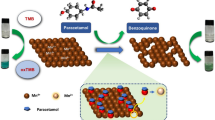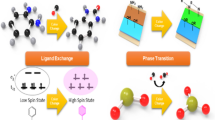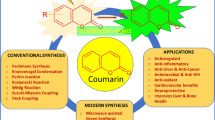Abstract
Chemical compounds belonging to the quinone class are known for their cyclic diketone structures. Anthraquinone derivatives have been used as sensing materials and dyes or pigments. The spectroscopic and voltammetric sensing capacity of 1-amino-4-hydroxy-9,10-anthraquinone was utilised to sense 2-bromobenzene-sulfonyl chloride, 4-nitrobenzene-sulfonyl chloride, benzoyl chloride, 2-chlorobenzoyl chloride, and 4-bromobenzoyl chloride. These substituted acyl chlorides and nitrobenzene-sulfonyl chloride are important intermediates in various reactions, and the product formation is highly dependent on their concentration. Therefore, it is crucial to take special care as all these compounds are carcinogenic. All studies were carried out in ethanol solvent. Results showed that 1-AHAQ could be effectively used as a UV–visible sensor for sensing 2-bromobenzene-sulfonyl chloride. 1-AHAQ demonstrates good results as a fluorescence sensor for sensing 4-bromobenzene-sulfonyl chloride and behaves as a good voltammetric sensor for sensing 4-nitrobenzene-sulfonyl chloride.
Graphical abstract















Similar content being viewed by others
Data availability
All the written material is new not a copy.
Code availability
Not applicable.
References
Ahmmed F, Islam AU, Mukhrish YE (2022) Efficient antibacterial/antifungal activities: synthesis, molecular docking, molecular dynamics. Pharmacokinetic Bind Free Energy Galactopyranoside Deriv 28(1):219
Ajloo D, Yoonesi B, Soleymanpour A (2010) Solvent effect on the reduction potential of anthraquinones derivatives. The experimental and computational studies. Int J Electrochem Sci 5:459–477
Alwi RS, Garlapati C, Tamura K (2021) Solubility of anthraquinone derivatives in supercritical carbon dioxide: new correlations. Molecules 26(2):460
Anowar Hosen M et al (2022) Synthesis, antimicrobial, molecular docking and molecular dynamics studies of lauroyl thymidine analogs against SARS-CoV-2: POM study and identification of the pharmacophore sites. Bioorg Chem 125:105850
Bhattacharya P, Mukherjee S, Mandal SM (2020) Fluoroquinolone antibiotics show genotoxic effect through DNA-binding and oxidative damage. Spectrochim Acta Part A Mol Biomol Spectrosc 227:117634
Bobe SR et al (2015) A near-infrared fluoride sensor based on a substituted naphthalenediimide–anthraquinone conjugate. Tetrahedron Lett 56(33):4762–4766
Caro Y et al (2012) Natural hydroxyanthraquinoid pigments as potent food grade colorants: an overview. Nat Prod Bioprospect 2(5):174–193
Carter MT, Rodriguez M, Bard AJ (1989) Voltammetric studies of the interaction of metal chelates with DNA. 2. Tris-chelated complexes of cobalt(III) and iron(II) with 1,10-phenanthroline and 2,2’-bipyridine. J Am Chem Soc 111(24):8901–8911
Çil E, Arslan M, Görgülü A (2006) Synthesis and characterization of benzyl and benzoyl substituted oxime-phosphazenes. Polyhedron 25(18):3526–3532
Dobo KL et al (2006) The application of structure-based assessment to support safety and chemistry diligence to manage genotoxic impurities in active pharmaceutical ingredients during drug development. Regul Toxicol Pharmacol 44(3):282–293
Dufossé L (2014) Anthraquinones, the Dr Jekyll and Mr Hyde of the food pigment family. Food Res Int 65:132–136
El Ashry ESH, Rashed N (2008) 10.16-Bicyclic 6–6 systems: three heteroatoms 1:2. In: Katritzky AR et al (eds) Comprehensive heterocyclic chemistry III. Elsevier, Oxford, pp 759–845
Erden I (1996) 1.03-Oxiranes and oxirenes: monocyclic. In: Katritzky AR, Rees CW, Scriven EFV (eds) Comprehensive heterocyclic chemistry II. Pergamon, Oxford, pp 97–144
Evans PD et al (2002) Weathering and photostability of benzoylated wood. Polym Degrad Stab 76(2):291–303
Forti J et al (2007) Electrochemical synthesis of hydrogen peroxide on oxygen-fed graphite/PTFE electrodes modified by 2-ethylanthraquinone. J Electroanal Chem 601(1–2):63–67
Gessler N, Egorova A, Belozerskaya T (2013) Fungal anthraquinones. Appl Biochem Microbiol 49(2):85–99
Gholivand M, Kashanian S, Peyman H (2012) DNA-binding, DNA cleavage and cytotoxicity studies of two anthraquinone derivatives. Spectrochim Acta Part A Mol Biomol Spectrosc 87:232–240
Guin PS, Das S (2014) Exploration of electrochemical intermediates of the anticancer drug doxorubicin hydrochloride using cyclic voltammetry and simulation studies with an evaluation for its interaction with DNA. Int J Electrochem 2014:517371
Guin PS, Das S, Mandal P (2008) Electrochemical reduction of sodium 1,4-dihydroxy-9,10-anthraquinone-2-sulphonate in aqueous and aqueous dimethyl formamide mixed solvent: a cyclic voltammetric study. Int J Electrochem Sci 3(9):1016–1028
Guin PS, Das S, Mandal P (2011) Electrochemical reduction of quinones in different media: a review. Int J Electrochem 2011:816202
Guin PS, Mandal P, Das S (2012a) A comparative study on the interaction with calf thymus DNA of a Ni(II) complex of the anticancer drug adriamycin and a Ni(II) complex of sodium 1,4-dihydroxy-9,10-anthraquinone-2-sulphonate. J Coord Chem 65(4):705–721
Guin PS, Mandal PC, Das S (2012b) The binding of a hydroxy-9, 10-anthraquinone cuii complex to calf thymus DNA: electrochemistry and UV/Vis spectroscopy. ChemPlusChem 77(5):361–369
He X et al (2023) Cyanine/iodonium salt as a broad-absorbing photoinitiating system for radical photopolymerization under near-UV, visible and NIR light. Polym Chem 14(13):1543–1553
Hill NS (2020) Theoretical mechanistic insights into ground-and excited-state approaches to modifying reactivity. The Australian National University (Australia)
Imran S et al (2018) Effect of electrolytes on the solubility and solution thermodynamics of 1-amino-4-hydroxy-9,10-anthraquinone, an analogue of anthracycline anticancer drugs, in aqueous ethanol media using theoretical and UV–Vis spectroscopic study. J Mol Liq 252:151–157
Kaur N (2023) Insight into the binding interactions of fluorenone-pendent Schiff base with calf thymus DNA. Anal Biochem 675:115216
Kopp MR et al (2022) Surface-induced protein aggregation and particle formation in biologics: current understanding of mechanisms, detection and mitigation strategies. J Pharmaceut Sci 112:377–385
Kostjukova LO, Leontieva SV, Kostjukov VV (2021) The vibronic absorption spectra and electronic states of acridine orange in aqueous solution. Spectrochim Acta Part A Mol Biomol Spectrosc 249:119302
Kulik PH (2008) Van Nostrand’s scientific encyclopedia. Wiley, New York
Kwon SA et al (2009) Photoresist composition and method of manufacturing a color filter substrate by using the same. Google Patents
Langdon-Jones EE, Pope SJ (2014) The coordination chemistry of substituted anthraquinones: developments and applications. Coord Chem Rev 269:32–53
Leggio A et al (2007) N-Nosyl-α-amino acids in solution phase peptide synthesis. Tetrahedron 63(34):8164–8173
Li DY et al (2022) Ultra-sensitive, selective and repeatable fluorescence sensor for methanol based on a highly emissive 0D hybrid lead-free perovskite. Angew Chem 134(35):e202206437
Mahadik SS et al (2022) Synthesis, optical, electrochemical and theoretical studies of 2, 3-di(pyridin-2-yl) quinoxaline amine derivatives as blue-orange emitters for organic electronics. J Mol Struct 1248:131541
Malik EM, Baqi Y, Müller CE (2015) Syntheses of 2-substituted 1-amino-4-bromoanthraquinones (bromaminic acid analogues)–precursors for dyes and drugs. Beilstein J Org Chem 11(1):2326–2333
Malik EM et al (2016) Ullmann reactions of 1-amino-4-bromoanthraquinones bearing various 2-substituents furnishing novel dyes. Dyes Pigm 131:33–40
Manisankar P, Gomathi A, Velayutham D (2005) Oxygen reduction at the surface of glassy carbon electrodes modified with anthraquinone derivatives and dyes. J Solid State Electrochem 9:601–608
Mehran S et al (2019) Study of the binding interaction between wortmannin and calf thymus DNA: multispectroscopic and molecular docking studies. Evid Based Complement Altern Med 2019:4936351
Motallebi S, Maghsoodi S (2013) Anthraquinone dye-containing material, composition including the same, camera including the same, and associated methods. Google Patents
Müthing J (2000) [6]-Analyses of glycosphingollpids by high-performance liquid chromatography. In: Merrill AH, Hannun YA (eds) Methods in enzymology. Academic Press, pp 45–64
Nikolić MA et al (2021) Binuclear Co(II) complexes with macrocycle and carboxylato ligands: structure, cytotoxicity and thermal behavior. J Mol Struct 1236:130133
Nimal R, Shah A, Saddiq M (2020) Thermodynamic characterisation of triazol ylimino-DNA interaction by UV–Vis spectroscopy. J Photochem Photobiol 2:100006
Palit DK et al (1991) Photodynamics of the S1 state of some hydroxy- and amino-substituted naphthoquinones and anthraquinones. ChemInform 8:22
Pankewitz F et al (2007) Anthraquinones as defensive compounds in eggs of Galerucini leaf beetles: biosynthesis by the beetles? Arch Insect Biochem Physiol 66(2):98–108
Pulyani M, Chauhan S (2023) Aloevera and banana sap as biomordant for dyeing of bamboo fabric with natural dyes
Qi W et al (2009) Glucose-sensitive microcapsules from glutaraldehyde cross-linked hemoglobin and glucose oxidase. Biomacromol 10(5):1212–1216
Radi A, El Ries M, Kandil S (2003) Electrochemical study of the interaction of levofloxacin with DNA. Anal Chim Acta 495(1–2):61–67
Ramotowska S et al (2019) Hydrogen bonding and protonation effects in amino acids’ anthraquinone derivatives-spectroscopic and electrochemical studies. Spectrochim Acta Part A Mol Biomol Spectrosc 222:117226
Roy S, Guin PS (2014) Solvation of 1-amino-4-Hydroxy-9, 10-anthraquinone governs its electrochemical behavior in non-aqueous and aqueous media: a cyclic voltammetry study. J Electrochem Soc 162(3):H124
Roy S, Guin PS (2015) Investigation on the interaction of 1-amino-4-hydroxy-9, 10-anthraquinone with calf thymus DNA and CTAB micelles. J Mol Liq 211:846–853
Roy S et al (2015) Spectroscopic, computational and electrochemical studies on the formation of the copper complex of 1-amino-4-hydroxy-9, 10-anthraquinone and effect of it on superoxide formation by NADH dehydrogenase. Dalton Trans 44(12):5428–5440
Saini R, Kaur N, Kumar S (2014) Quinones based molecular receptors for recognition of anions and metal ions. Tetrahedron 70(29):4285–4307
Shahabadi N, Akhtarshenas S, Hadidi S (2019) Synthesis, characterization and DNA interaction studies of new copper complex containing pseudoephedrine hydrochloride drug. Nucleosides Nucleotides Nucleic Acids 38(9):680–699
Shaikh AM, Chacko S, Kamble RM (2017) Synthesis, optoelectronic and theoretical investigation of anthraquinone amine-based donor−acceptor derivatives. ChemistrySelect 2(25):7620–7629
Shaw DW (2009) Allergic contact dermatitis from carmine. Dermatitis 20(5):292–295
Sheeba KRJ et al (2023) Enhancing structural, thermal, and mechanical properties of Acacia pennata natural fibers through benzoyl chloride treatment for construction applications. Case Stud Constr Mater 19:e02443
Suktham K, Daisuk P, Shotipruk A (2021) Microwave-assisted extraction of antioxidative anthraquinones from roots of Morinda citrifolia L. (Rubiaceae): errata and review of technological development and prospects. Sep Purif Technol 256:117844
Sun L et al (2023) Synthetic approaches and application of clinically approved small-molecule anti-HIV drugs: an update. Eur J Med Chem 8:115847
Tang Z et al (2022) Cinnamoylformate derivatives photoinitiators with excellent photobleaching ability and cytocompatibility for visible LED photopolymerization. Prog Org Coat 170:106969
Uchimiya M, Stone AT (2009) Reversible redox chemistry of quinones: impact on biogeochemical cycles. Chemosphere 77(4):451–458
Wang L et al (2023) Conformational changes to zein and its binding interactions with sodium caseinate during the pH-driven self-assembly using multi-spectroscopic and hydrostatic methods. Food Hydrocoll 136:108225
Wannajuk K et al (2012) Highly specific-glucose fluorescence sensing based on boronic anthraquinone derivatives via the GOx enzymatic reaction. Tetrahedron 68(43):8899–8904
Zhao C, Huang L, Wang Q (2022) Novel mononuclear zinc(II) complex with niacin: crystal structure, DNA/protein interaction, and cytotoxicity studies. J Appl Spectrosc 8:1–10
Funding
No fundings.
Author information
Authors and Affiliations
Contributions
Concept and design of this article is collective contribution of all authors. They all read and approve the final manuscript of this research article. Bushra Tariq along with Sadia Asim plays a vital role in collecting data regarding the absorption and emission studies of 1-amino-4-hydroxy-9,10-Anthraquinone and effect of salts on selected fluorophore to be used as sensor. The voltammetric studies regarding the effect of salts on 1-amino-4-hydroxy-9,10-anthraquinone and its uses as voltammetric sensor were carried out by Asim Mansha and Sobia Noreen. The first draft of manuscript was written by Bushra Tariq which was later refined by Sadia Asim, Sobia Noreen and Asim Mansha.
Corresponding authors
Ethics declarations
Conflict of interest
The review article entitled “sensory detection of selective substituted acyl chloride and nitrobenzene-sulfonyl chloride by interaction with1-amino-4-hydroxy-9,10-anthraquinone using spectrophotometry and cyclic voltammetry”. All the authors involved in the write up of this article do not have any conflict of interest.
Ethics approval
Not applicable.
Consent to participate
Yes, i got permission.
Consent for publication
Yes, u can publish it.
Additional information
Publisher's Note
Springer Nature remains neutral with regard to jurisdictional claims in published maps and institutional affiliations.
Rights and permissions
Springer Nature or its licensor (e.g. a society or other partner) holds exclusive rights to this article under a publishing agreement with the author(s) or other rightsholder(s); author self-archiving of the accepted manuscript version of this article is solely governed by the terms of such publishing agreement and applicable law.
About this article
Cite this article
Tariq, B., Mansha, A., Asim, S. et al. Sensory detection of selective substituted acyl chloride and nitrobenzene-sulfonyl chloride by interaction with 1-amino-4-hydroxy-9,10-anthraquinone using spectrophotometry and cyclic voltammetry. Chem. Pap. (2024). https://doi.org/10.1007/s11696-024-03546-8
Received:
Accepted:
Published:
DOI: https://doi.org/10.1007/s11696-024-03546-8




